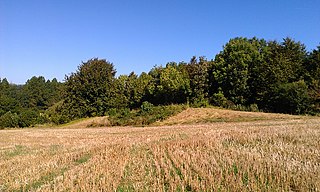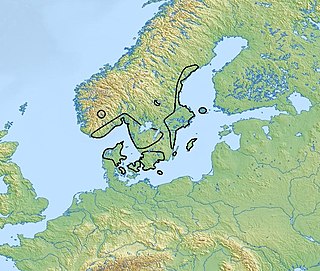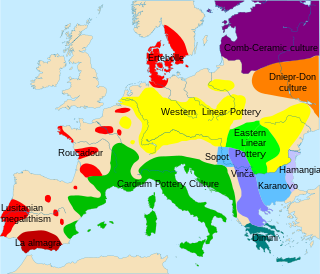
The Corded Ware culture comprises a broad archaeological horizon of Europe between c. 3000 BC – 2350 BC, thus from the late Neolithic, through the Copper Age, and ending in the early Bronze Age. Corded Ware culture encompassed a vast area, from the contact zone between the Yamnaya culture and the Corded Ware culture in south Central Europe, to the Rhine in the west and the Volga in the east, occupying parts of Northern Europe, Central Europe and Eastern Europe. Early autosomal genetic studies suggested that the Corded Ware culture originated from the westward migration of Yamnaya-related people from the steppe-forest zone into the territory of late Neolithic European cultures; however, paternal DNA evidence fails to support this hypothesis, and it is now proposed that the Corded Ware culture evolved in parallel with the Yamnaya, with no evidence of direct male-line descent between them.

Julliberrie's Grave, also known as The Giant's Grave or The Grave, is an unchambered long barrow located near to the village of Chilham in the south-eastern English county of Kent. Probably constructed in the fourth millennium BCE, during Britain's Early Neolithic period, today it survives only in a state of ruin.

The Globular Amphora culture (GAC, German: Kugelamphoren-Kultur ; c. 3400–2800 BC, is an archaeological culture in Central Europe. Marija Gimbutas assumed an Indo-European origin, though this is contradicted by newer genetic studies that show a connection to the earlier wave of Early European Farmers rather than to Western Steppe Herders from the Ukrainian and south-western Russian steppes.

The Dnieper–Donets culture complex (DDCC) is a Mesolithic and later Neolithic archaeological culture found north of the Black Sea and dating to ca. 5000-4200 BC. It has many parallels with the Samara culture, and was succeeded by the Sredny Stog culture.

Deriivka is an archaeological site located in the village of the same name in Kirovohrad Oblast, Ukraine, on the right bank of the Dnieper. The site dates to ca. 4500—3500 BC and is associated with the Sredny Stog culture.

The Pitted Ware culture was a hunter-gatherer culture in southern Scandinavia, mainly along the coasts of Svealand, Götaland, Åland, north-eastern Denmark and southern Norway. Despite its Mesolithic economy, it is by convention classed as Neolithic, since it falls within the period in which farming reached Scandinavia. The Pitted Ware people were largely maritime hunters, and were engaged in lively trade with both the agricultural communities of the Scandinavian interior and other hunter-gatherers of the Baltic Sea.
The Narva culture or eastern Baltic was a European Neolithic archaeological culture in present-day Estonia, Latvia, Lithuania, Kaliningrad Oblast, and adjacent portions of Poland, Belarus and Russia. A successor of the Mesolithic Kunda culture, the Narva culture continued up to the start of the Bronze Age. The culture spanned from c. 5300 to 1750 BC. The technology was that of hunter-gatherers. The culture was named after the Narva River in Estonia.
The Kunda culture, which originated from the Swiderian culture, comprised Mesolithic hunter-gatherer communities of the Baltic forest zone extending eastwards through Latvia into northern Russia, dating to the period 8500–5000 BC according to calibrated radiocarbon dating. It is named after the Estonian town of Kunda, about 110 kilometres (70 mi) east of Tallinn along the Gulf of Finland, near where the first extensively studied settlement was discovered on Lammasmäe Hill and in the surrounding peat bog. The oldest known settlement of the Kunda culture in Estonia is Pulli. The Kunda culture was succeeded by the Narva culture, who used pottery and showed some traces of food production.

Haplogroup R1b (R-M343), previously known as Hg1 and Eu18, is a human Y-chromosome haplogroup.

The Linear Pottery culture (LBK) is a major archaeological horizon of the European Neolithic period, flourishing c. 5500–4500 BC. Derived from the German Linearbandkeramik, it is also known as the Linear Band Ware, Linear Ware, Linear Ceramics or Incised Ware culture, falling within the Danubian I culture of V. Gordon Childe.

The secondary burial, or “double funeral” is a feature of prehistoric and historic gravesites. The term refers to remains that represent an exhumation and reburial, whether intentional or accidental.

The Karsdorf remains are the bodies of more than 30 Neolithic humans who were buried in the vicinity of Karsdorf, Sachsen-Anhalt, Germany.

Birka grave Bj 581 held a female buried in a weapons grave during the 10th century in Birka, Sweden. Although the remains had been thought to be of a male warrior since the grave's excavation in 1878, both a 2014 osteological analysis and a 2017 DNA study proved that the remains were of a female. A 2017 study claimed the person in Bj 581 was a high ranking professional warrior. The study attracted worldwide attention, as well as criticism from some academics who disputed the interpretation of burial goods.

The Iron Gates Mesolithic is a Mesolithic archaeological culture dated to between 13,000 and 6,000 years cal BCE, in the Iron Gates region of the Danube River, in modern Romania and Serbia.

In archaeogenetics, the term Western Hunter-Gatherer (WHG), West European Hunter-Gatherer, Western European Hunter-Gatherer, Villabruna cluster, or Oberkassel cluster is the name given to a distinct ancestral component of modern Europeans, representing descent from a population of Mesolithic hunter-gatherers who scattered over Western, Southern and Central Europe, from the British Isles in the west to the Carpathians in the east, following the retreat of the ice sheet of the Last Glacial Maximum.

In archaeogenetics, the term Eastern Hunter-Gatherer (EHG), sometimes East European Hunter-Gatherer, or Eastern European Hunter-Gatherer is the name given to a distinct ancestral component that represents Mesolithic hunter-gatherers of Eastern Europe.
Bodzia Cemetery is a large 10th – 11th century chamber burial site in Bodzia, a town in the Kuyavia region of Central Poland, approximately 15 km to the northwest of Włocławek. A group from the Polish Academy of Sciences, led by Polish archaeologist, Andrzej Buko, excavated this site between 2007 – 2009. The excavation uncovered a large elite necropolis containing more than 58 graves, cenotaphs, weapons and riches. The Bodzia Cemetery is considered to be one of the most significant and "spectacular" Early Medieval findings in Poland in the last century. Artefacts uncovered in the site were mostly of foreign origin, which is atypical of other sites in the area. Information gleaned from the Bodzia Cemetery provided archaeologists with evidence of burial practices during the Early Medieval period in Poland.

In archaeogenetics, the term Scandinavian Hunter-Gatherer (SHG) is the name given to a distinct ancestral component that represents descent from Mesolithic hunter-gatherers of Scandinavia. Genetic studies suggest that the SHGs were a mix of Western Hunter-Gatherers (WHGs) initially populating Scandinavia from the south during the Holocene, and Eastern Hunter-Gatherers (EHGs), who later entered Scandinavia from the north along the Norwegian coast. During the Neolithic, they admixed further with Early European Farmers (EEFs) and Western Steppe Herders (WSHs). Genetic continuity has been detected between the SHGs and members of the Pitted Ware culture (PWC), and to a certain degree, between SHGs and modern northern Europeans. The Sámi, on the other hand, have been found to be completely unrelated to the PWC.
The Schalkholz Passage Grave, also known as Schalkholz-Vierth is a megalithic burial site of the Neolithic period and of the Funnelbeaker culture in Vierth, a district of Schalkholz in the province of Schleswig-Holstein in Germany. During the late Bronze Age or early Iron Age, it was used for a secondary burial site and was expanded upon. It has the Sprockhoff number 139 and the site number LA 33 or Heide LA 5. The grave was archaeologically investigated in 1969 and 1970 and was afterwards moved to the nearby town of Heide. In 2021 it was moved back to Schalkholz.
Al-Khiday is an archeological collection of 5 established sites in central Sudan on the Western bank of the White Nile near Khartoum. It was discovered through survey alongside the construction of a new road by the Italian Archeological Mission in 2004. The most significant of these sites is al-Khiday 2, a multi-staged cemetery which encompasses the span of occupation at this location. The site contains evidence of discrete period occupations identified through burial phases, associated goods and living floors. These periods are the Pre-Mesolithic, Mesolithic, Neolithic and Classic/Late Meroitic.















